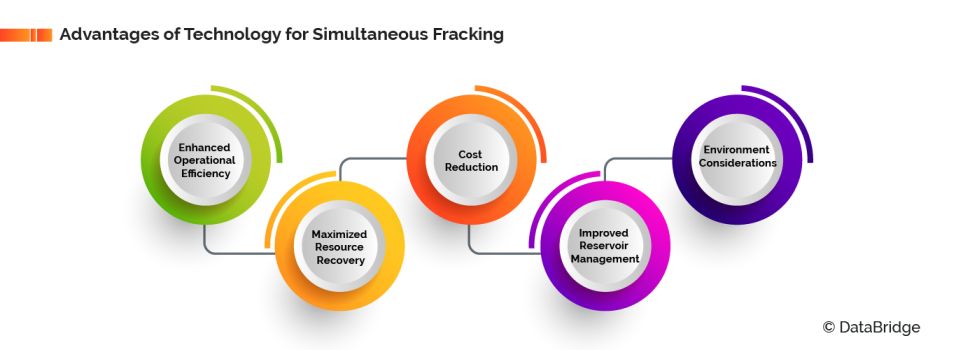Introduction
Although the extraction of shale gas and oil has become a crucial aspect for the world's energy production, conventional fracking techniques frequently encounter issues with productivity and efficiency. As a potential remedy, the upstream oil and gas industry has embraced simultaneous fracking technology or simul-frac.
Evolution of Simultaneous Fracking Technology
Also referred to as "zipper fracking" or "simul-frac," simultaneous fracking differs from traditional sequential fracking techniques. Hydraulic fracturing was previously done sequentially, requiring downtime in between operations, while each well was fractured separately. This conventional approach limited output and increased operating expenses since it was labor-intensive and inefficient.
The pursuit of increased operational efficiency and cost-effectiveness is the origin of simultaneous fracking technology. Operators looked for ways to reduce downtime and maximize output rates. In order to maximize resource recovery and streamline operations, the idea of simultaneous fracking was developed as a solution. Its goal is to synchronize the fracturing of various wells within proximity.
Operators realized that simultaneous fracturing may transform the production of oil and shale gas, and as a result, its use accelerated. Operators might better utilize reservoirs by fracturing numerous wells at the same time, which would improve reservoir drainage and increase production rates. This change in strategy ushered in a new phase of profitable and efficient unconventional resource production.
Advantages of Technology for Simultaneous Fracking:

- Enhanced Operational Efficiency:- By timing the fracturing of several wells at once, simultaneous fracking reduces downtime. This resource optimization results in increased operational effectiveness and shortened project completion times
- Maximized Resource Recovery:- Operators can efficiently utilize reservoirs, optimizing resource recovery and raising total production rates by simultaneously fracturing numerous wells
- Cost Reduction: Simultaneous fracking's streamlined design lowers operational expenses related to equipment mobility and downtime. Operators save a lot of money thanks to economies of scale and efficient resource utilization
- Improved Reservoir Management: Better reservoir management is made possible by simultaneous fracking, which guarantees even pressure distribution and improved drainage effectiveness. Longer well lifespans and sustainable resource exploitation are facilitated by this
- Environmental Considerations: Simultaneous fracking presents potential environmental benefits even if hydraulic fracturing operations have sparked concerns. It minimizes environmental effects while maximizing resource recovery by minimizing the overall footprint of activities and optimizing resource consumption.
Hydraulic fracturing, or fracking, can aid environmental considerations by providing access to natural gas, which emits fewer greenhouse gases than coal when burned for electricity. This shift can contribute to mitigating climate change while supporting energy independence and economic growth, though careful management is essential to address associated risks.
To know about the Global Hydraulic Fracturing Market, kindly visit the link below:- https://www.databridgemarketresearch.com/reports/global-hydraulic-fracturing-market
Ramifications in the Upstream Oil and Gas Industry
Shale gas and oil extraction have become a revolutionary force in the upstream oil and gas sector, which has long been a mainstay of the world's energy production. Among the methods used, simultaneous fracking technology has become increasingly popular, indicating a major change in industry standards and operational strategy.
Simultaneous fracking entails the simultaneous hydraulic fracturing of many nearby wells. Fracking was conducted on a single well basis, progressing sequentially. However, operators now maximize resource recovery, cut costs, and increase efficiency due to simultaneous fracking.
Accelerating project timeliness is one of the main reasons why simultaneous fracking is becoming more and more acceptable. Operators can shorten the total completion timetable and drastically cut down on the amount of time needed to bring wells online by fracking numerous wells at once. This accelerated schedule results in early income generation and a quicker return on investment, which is important in the fiercely competitive upstream industry.
Simultaneous fracking also provides logistical benefits that reduce downtime and streamline operations. Careful planning and implementation are necessary to coordinate the necessary equipment, personnel, and resources for simultaneous fracking. But once it's going, this method cuts down on downtime in between fracking phases, maximizing efficiency and cutting expenses related to mobilizing and demobilizing equipment.
Moreover, concurrent fracking may result in economies of scale, lowering well-specific expenses and enhancing project economics as a whole. Operators can obtain cost efficiencies through shared infrastructure and operational synergies that are not possible with sequential fracking methods. This cost-effectiveness is especially beneficial in shale plays where high drilling density and substantial well development are present.
Simultaneous fracking also has the potential to lessen its negative effects on the environment. Operators can limit surface disturbances, minimize truck traffic, and mitigate emissions related to equipment mobility by grouping fracking operations into small area. In addition, more sustainable methods of extracting oil and shale gas can be facilitated by the economical use of resources such as proppants and water.
The increasing acceptability of simultaneous fracking is a reflection of both technological and engineering know-how advances. Advances in fracture modeling, well design, and real-time monitoring have made simultaneous operations more practical and efficient, allowing operators to maximize production results while reducing operating hazards.
Simultaneous fracking does provide certain difficulties and issues, though. It takes careful planning and execution to coordinate several fracking operations in close proximity in order to avoid well interaction and guarantee efficient reservoir stimulation. Additionally, a high degree of proficiency and operational competence are needed to manage the logistical challenges of simultaneous activities.
For instant,
Obstacles & Things to Think About

- Technical Complexity: Advanced engineering knowledge and specialized tools are needed to implement simultaneous fracking. Well spacing, pressure control, and fracturing synchronization present technical obstacles for operators to overcome
- Regulatory Compliance: Widespread adoption of hydraulic fracturing is hampered by the diverse regulatory environments across different locations. In order to guarantee adherence to environmental regulations and operational prerequisites, operators have to maneuver through intricate regulatory structures
In the well testing services market, hydraulic fracturing plays a crucial role, particularly in assessing the productivity of oil and gas wells. Well testing involves gathering data on the flow, pressure, and composition of fluids produced from a well to evaluate its potential and performance. Hydraulic fracturing is often employed as a method to stimulate production from reservoirs, especially unconventional ones such as shale formations.
To know about the Global Hydraulic Fracturing Well Testing Services Market-, kindly visit the link below:- https://www.databridgemarketresearch.com/reports/global-hydraulic-fracturing-well-testing-services-market
- Infrastructure Limitations: Strong infrastructure and logistical assistance are required for the implementation of simultaneous fracking technologies. Inadequate infrastructure in remote or impoverished areas may make it difficult to execute, requiring a large investment
- Economic Viability: Even though simultaneous fracking has the potential to save costs and improve operations, its economic feasibility is dependent on a number of variables, such as project economics, market demand, and commodity pricing. To determine whether it is feasible, operators must perform in-depth cost-benefit evaluations
- Public Perception: Concerns about the ecology and public debate have been raised by hydraulic fracturing operations. Ensuring transparency in operational processes and addressing public perception may be crucial for the acceptance of simultaneous fracking technology
New Tech Supports Revenue Production
Shale company experts predicted that if major producers such as Chevron Corp (CVX.N) and Exxon Mobil Corp (XOM.N) implement innovations more widely, they will acquire traction.
The first to adopt the new techniques were mid-sized shale companies such as Pioneer Natural Resources (PXD.N), which opens a new tab and can pay the costs. Large companies such as Exxon, which is awaiting regulatory approval to acquire Pioneer, find them more appealing as a result of the favorable outcomes.
However, rather than drilling further, the largest shale producers have committed to using oil earnings to finance shareholder dividends. Exxon and Chevron, two of the largest producers of shale oil, have fallen short of their Permian output goals in recent years.
By 2027, Exxon company expects to triple its output at Pioneer to 2 million barrels of oil equivalent per day (BOEPD) due to its innovative fracking method, which will enable it to extract an additional 700,000 boepd from its properties.
Chevron company claims that by using more simul-fracs, it will be able to increase Permian production to 900,000 boepd this year, a 10% increase. According to a spokesman, it also finished a triple-frac pilot and plans to use it more extensively.
Conclusion
In conclusion, the rising acceptability of simultaneous fracking technology among shale gas and oil operators reflects a paradigm shift in upstream operations driven by the pursuit of efficiency, cost-effectiveness, and sustainability. By enabling faster project timelines, optimizing resource utilization, and reducing environmental footprints, simultaneous fracking holds significant promise for the continued development of shale resources while navigating the complex landscape of energy production in the 21st century.
An important turning point in the development of the upstream oil and gas sector is the growing acceptance of simultaneous fracking technology. A new era of resource optimization, environmental stewardship, and operational efficiency is being ushered in by this revolutionary technique to hydraulic fracturing. Simultaneous fracking is becoming a key component of operators' operational strategies, and as a result, its widespread adoption is expected to change the dynamics of the industry, spur technological advancement, and change the face of energy for years to come.

